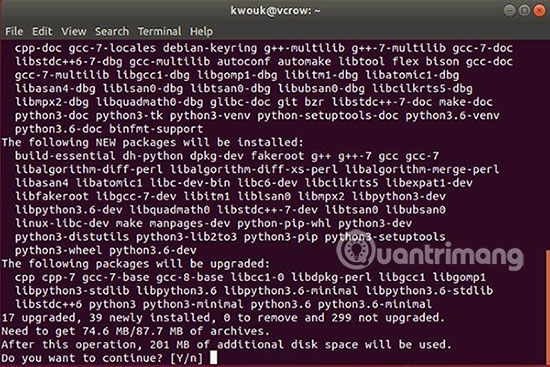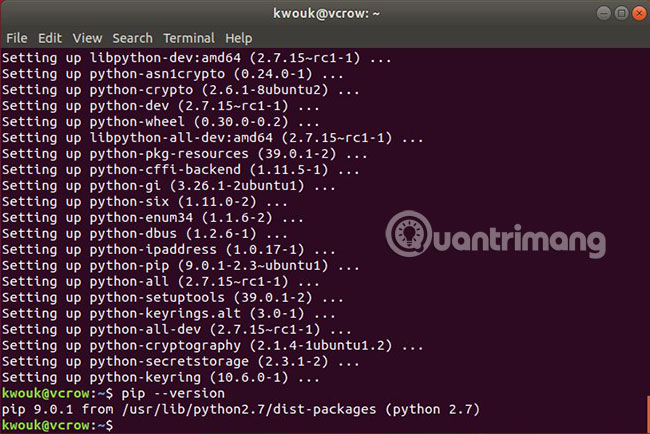How to install Pip in Ubuntu
Linux has a lot of package managers. Ubuntu not only has apt but also many programming languages that come with its own package manager. Node.js has npm, Ruby has a gem and Python has pips.
Pip stands for Python Packages Packages and allows you to easily install packages from Python Package Index (PyPI). You can also use pip to install from other indexes, but most of what you need will usually be available on PyPI. To use pip for installing packages, you first need to install this tool on your system.
Instructions for installing Pip in Ubuntu
- Which version of pip do you need?
- How to install pip for Python 3
- How to install pip for Python 2
- Should I use pip or Apt?
Which version of pip do you need?
If you are completely familiar with Python, you probably know that Python 3 has been around for a long time. However, due to major changes between Python 2 and Python 3, many Linux distributions include both versions by default. Therefore, pip also has 2 versions.
The newer Ubuntu versions only come with Python 3 installed by default. If you need pip for Python 2, you will also need to install Python 2.
Which version you need depends on the package you want to install. But anyway, this process is relatively easy. Today's article will show you how to install both versions.
How to install pip for Python 3
The first thing to do before you start is to make sure the package list has been updated. Do this by running apt:
sudo apt update This process will take some time. When completed, you can switch to the actual pip setting. To do this, run the following command:
sudo apt install python3-pip 
Confirm that you want to install the packages and wait for the process to complete. When this is done, confirm that the installed package is correct by checking the version:
pip3 --version 
How to install pip for Python 2
As mentioned above, if you need pip for Python 2, you also need to install Python 2. However, this is easy because Python 2 will be installed as a dependency for pip.
First, make sure the package list is updated:
sudo apt update When this is done, you can install pip by the following command:
sudo apt install python-pip 
Confirm that you want to install pip and its dependencies, then wait for the installation process to complete. When this is over, make sure everything is installed correctly by checking the version:
pip --version 
Should I use pip or Apt?
In some cases, you'll see that packages are available in both Python Package Index and through Apt. If you have to choose, you should stick with the installation via Apt, since these versions have been tested to work on Ubuntu. In most cases, you will only want to use pip if the package is not available via Apt or if you need a specific version.
Please note that you may need to install pip for both Python 2 and Python 3. Some packages are only available for certain python versions and other software may have either version or both. For example, Neovim allows users to create add-ons in both Python 2 and Python 3, based on having a separate package installed in both pip versions.
If you are a developer, chances are you have installed pip. If this is the case, take the time to review the list of TipsMake.com 's best Python IDE's .
Hope you are succesful.
You should read it
- Ways to install Ubuntu on Windows, run in parallel or run separately
- Instructions to install Ubuntu directly from the hard drive
- Instructions for installing Google Chrome on Ubuntu operating system
- How to install Steam in Ubuntu
- Instructions for installing Ubuntu on VMware Workstation - Part 2
- Instructions on how to install Ubuntu on VirtualBox virtual machine
- How to install Hyper Terminal in Ubuntu 20.04
- What's New in Ubuntu 21.10?
May be interested
- How to Install Ubuntu Linux Without CD (Windows)
 want to install ubuntu on your windows computer, but don't have a dvd or cd drive? there are a couple of different ways that you can install ubuntu on computers that don't have disc drives. the most common way is to create a bootable usb...
want to install ubuntu on your windows computer, but don't have a dvd or cd drive? there are a couple of different ways that you can install ubuntu on computers that don't have disc drives. the most common way is to create a bootable usb... - How to Install ClickHouse on Ubuntu 22.04
 clickhouse is a modern, fast and open source database management system used for online analytical processing (olap).
clickhouse is a modern, fast and open source database management system used for online analytical processing (olap). - How to install MySQL on Ubuntu 20.04
 in this article, tipsmake will show how to install mysql version 8.0 on ubuntu 20.04 server. by completing it, you'll have an active relational database that can be used to build your next website or app.
in this article, tipsmake will show how to install mysql version 8.0 on ubuntu 20.04 server. by completing it, you'll have an active relational database that can be used to build your next website or app. - How to install AVG Antivirus on Ubuntu
 in addition to windows, you can install avg antivirus on ubuntu easily and quickly to ensure that damage is minimized in the most optimal way. along with tipsmake, see how to install avg antivirus on ubuntu below.
in addition to windows, you can install avg antivirus on ubuntu easily and quickly to ensure that damage is minimized in the most optimal way. along with tipsmake, see how to install avg antivirus on ubuntu below. - How to install Ubuntu on a VMware virtual machine
 how to install ubuntu on a vmware virtual machine. ubuntu is a very popular operating system nowadays parallel to windows and macos. but ubuntu still makes many users wonder before upgrading should use on their own computers, so we still have a way to experience ubuntu.
how to install ubuntu on a vmware virtual machine. ubuntu is a very popular operating system nowadays parallel to windows and macos. but ubuntu still makes many users wonder before upgrading should use on their own computers, so we still have a way to experience ubuntu. - Ways to install Ubuntu on Windows, run in parallel or run separately
 there are many ways to install ubuntu on your computer, such as installing ubuntu from usb, cd, installing ubuntu running in parallel with windows, installing it
there are many ways to install ubuntu on your computer, such as installing ubuntu from usb, cd, installing ubuntu running in parallel with windows, installing it - What's New in Ubuntu 21.10?
 version 21.10 is the latest release of ubuntu and although canonical is turning more attention to the cloud and developers, ubuntu 'impish indri' still comes with some notable changes for those users use the ubuntu desktop every day.
version 21.10 is the latest release of ubuntu and although canonical is turning more attention to the cloud and developers, ubuntu 'impish indri' still comes with some notable changes for those users use the ubuntu desktop every day. - 10 software should install on Ubuntu
 you just moved from windows to ubuntu and wondered which ubuntu application is best and which software to install? below are the applications that should be installed on ubuntu after a fresh install.
you just moved from windows to ubuntu and wondered which ubuntu application is best and which software to install? below are the applications that should be installed on ubuntu after a fresh install. - How to install Blender 3D on Ubuntu 20.04
 blender 3d is a professional open source 3d graphics and animation software. it has a rich feature set like animations, visual effects, 3d modeling and motion graphics.
blender 3d is a professional open source 3d graphics and animation software. it has a rich feature set like animations, visual effects, 3d modeling and motion graphics. - How to Install Ubuntu Packages
 this wikihow will show you how to install packages on ubuntu using the ubuntu software center, the synaptic package manager, and a command-line window. the ubuntu software center is similar to the app store for macos and the microsoft...
this wikihow will show you how to install packages on ubuntu using the ubuntu software center, the synaptic package manager, and a command-line window. the ubuntu software center is similar to the app store for macos and the microsoft...










 How to configure static IP addresses on Linux
How to configure static IP addresses on Linux 7 best antivirus programs for Ubuntu
7 best antivirus programs for Ubuntu How to check for simple Linux server performance
How to check for simple Linux server performance Check the current user on Linux
Check the current user on Linux How to display the date and time in Linux Terminal
How to display the date and time in Linux Terminal How to check the time of shutdown and reboot in Linux
How to check the time of shutdown and reboot in Linux